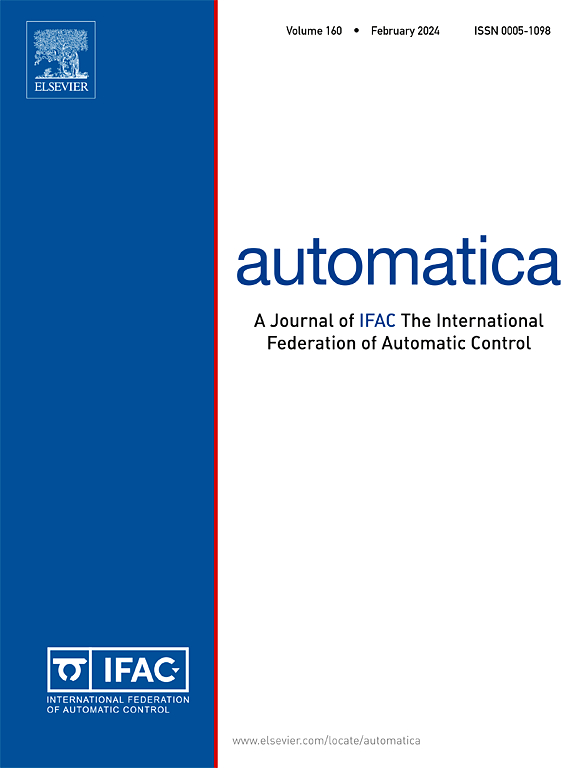Nature-inspired dynamic control for pursuit-evasion of robots
IF 5.9
2区 计算机科学
Q1 AUTOMATION & CONTROL SYSTEMS
引用次数: 0
Abstract
The pursuit-evasion problem is widespread in nature, engineering, and societal applications. It is commonly observed in nature that predators often exhibit faster speeds than their prey but have less agile maneuverability. Over millions of years of evolution, animals have developed effective and efficient strategies for pursuit and evasion. In this paper, we provide a dynamic framework for the pursuit-evasion problem of unicycle systems, drawing inspiration from nature. First, we address the scenario with one pursuer and one evader by proposing an Alert-Turn control strategy, which consists of two efficient ingredients: a sudden turning maneuver and an alert condition for starting and maintaining the maneuver. We present and analyze the escape and capture results at two levels: a lower level of a single run and a higher level with respect to parameters’ changes. In addition, we provide a theorem with sufficient conditions for capture. The Alert-Turn strategy is then extended to more complex scenarios involving multiple pursuers and evaders by integrating aggregation control laws and a target-changing mechanism. By adjusting a ‘selfish parameter’, the aggregation control commands produce various escape patterns of evaders: cooperative mode, selfish mode, and their combinations. The influence of the selfish parameter is quantified, and the target-changing mechanism is explored from a statistical perspective. Our findings align closely with observations in nature. Finally, the proposed strategies are validated through numerical simulations that replicate some chasing behaviors of animals in nature.
基于自然的机器人追逃动态控制
追逃问题在自然界、工程和社会应用中普遍存在。在自然界中,捕食者通常表现出比猎物更快的速度,但机动性却不如猎物敏捷。在数百万年的进化过程中,动物已经发展出了有效的追捕和逃避策略。在本文中,我们从自然界中汲取灵感,为独轮车系统的追逃问题提供了一个动态框架。首先,我们提出了一种警报-转向控制策略,该策略由两个有效成分组成:一个突然转向机动和一个启动和保持机动的警报条件。我们在两个级别上呈现和分析escape和capture结果:单个运行的较低级别和相对于参数变化的较高级别。此外,我们还提供了一个具有捕获充分条件的定理。然后,通过整合聚合控制律和目标改变机制,将警报-转向策略扩展到涉及多个追捕者和逃避者的更复杂场景。通过调整一个“自私参数”,聚合控制命令产生各种逃逃者的逃避模式:合作模式、自私模式以及它们的组合。量化了自利参数的影响,并从统计学角度探讨了目标改变机制。我们的发现与自然界的观察结果密切相关。最后,通过模拟动物在自然界的追逐行为,验证了所提出的策略。
本文章由计算机程序翻译,如有差异,请以英文原文为准。
求助全文
约1分钟内获得全文
求助全文
来源期刊

Automatica
工程技术-工程:电子与电气
CiteScore
10.70
自引率
7.80%
发文量
617
审稿时长
5 months
期刊介绍:
Automatica is a leading archival publication in the field of systems and control. The field encompasses today a broad set of areas and topics, and is thriving not only within itself but also in terms of its impact on other fields, such as communications, computers, biology, energy and economics. Since its inception in 1963, Automatica has kept abreast with the evolution of the field over the years, and has emerged as a leading publication driving the trends in the field.
After being founded in 1963, Automatica became a journal of the International Federation of Automatic Control (IFAC) in 1969. It features a characteristic blend of theoretical and applied papers of archival, lasting value, reporting cutting edge research results by authors across the globe. It features articles in distinct categories, including regular, brief and survey papers, technical communiqués, correspondence items, as well as reviews on published books of interest to the readership. It occasionally publishes special issues on emerging new topics or established mature topics of interest to a broad audience.
Automatica solicits original high-quality contributions in all the categories listed above, and in all areas of systems and control interpreted in a broad sense and evolving constantly. They may be submitted directly to a subject editor or to the Editor-in-Chief if not sure about the subject area. Editorial procedures in place assure careful, fair, and prompt handling of all submitted articles. Accepted papers appear in the journal in the shortest time feasible given production time constraints.
 求助内容:
求助内容: 应助结果提醒方式:
应助结果提醒方式:


